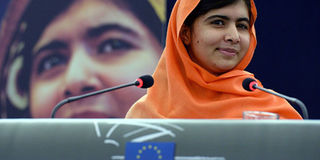Why 10 is very malleable in forming complex numbers

Pakistani teenager Malala Yousafzai addressing the European Parliament assembly on November 20, 2013. All speakers of English - a language which belongs to the Indo-European group — know at least two other forms of ten, namely, teen and ty, writes Philip Ochieng. PHOTO | PATRICK HERTZOG | FILE
What you need to know:
- Old English contained the most recent roots to which we can trace those two words — namely, endleofan for “eleven” and twelf for “twelve”.
- While, in English, there is no such thing as “tenteen” (for “twenty”) or “tenten” (for “a hundred”), pierapar (from aparapar) is the proper Dholuo word for “a hundred”.
In English and Dholuo, and probably most other world languages, the word for 10 is the most malleable in forming words for complex numbers.
All speakers of English - a language which belongs to the Indo-European group — know at least two other forms of ten, namely, teen and ty.
Ten, the basic form, is related, through a common Teutonic root, to the German zehn (pronounced tsen).
The English words for most numbers between eleven and nineteen, are formed by adding the word teen to a single-digit number (between one and nine).
Thus we have thirteen (literally meaning “three and ten” or “three plus ten”), and we have fourteen, fifteen, sixteen, seventeen, eighteen and nineteen. Teen, then — that is why all our children between eleven and nineteen are called teenagers, that is to say, people in theirs “tens”.
I say “most numbers” because the first two of these — eleven and twelve – are basic (Teutonic) numbers.
As far as I know, Old English contained the most recent roots to which we can trace those two words — namely, endleofan for “eleven” and twelf for “twelve”. German has thinned endleofan down to a simple 'elf'.
CARDINAL NUMBERS
Beyond that — between twenty and a hundred — all cardinal numbers are known in English by yet another form of ten, namely, the ty. You are all familiar with it at the end of all round numbers between twenty and ninety. For, respectively, the words twenty and ninety simply mean “two tens” and “nine tens”.
But, to go on counting, we have to interpose between each of those basic “tens” either one or another number of the items that protrude from your hands and from which you learned how to count. Twenty-one, for instance, literally means “two tens plus one”.
About this, Dholuo seems more pliable than English because even apar — the cardinal “ten” — can be attached to itself to form a multiple number. While, in English, there is no such thing as “tenteen” (for “twenty”) or “tenten” (for “a hundred”), pierapar (from aparapar) is the proper Dholuo word for “a hundred”.
I say “proper” because most Jokapodho — a term often used for the Luo of Kenya and Tanzania (as opposed to the Luo of Uganda, Congo, Sudan, Ethiopia and Eritrea) — have for a long time adopted from Kiswahili the much easier word mia, Bantu for ten multiplied by itself.
ORIGIN
Apar (the cardinal ten) becomes piero when multiplied by a small number (between two and nine). For instance, twenty is pierariyo (“two tens”), and thirty is pieradek (“three tens”), where ariyo and adek are the respective words for “two” and “three”.
And a hundred is pierapar (aparapar), that is, “apar twice” or “two tens multiplied together”.
But I don’t know whether there was once, in the Teutonic system, a word translatable as “ten tens”. The English hundred and German Hundert do not suggest it.
However, in many contexts of that numerical concept, the English have used the French cent (from the Latin centum) ever since William of Normandy rode roughshod over England in 1066.





